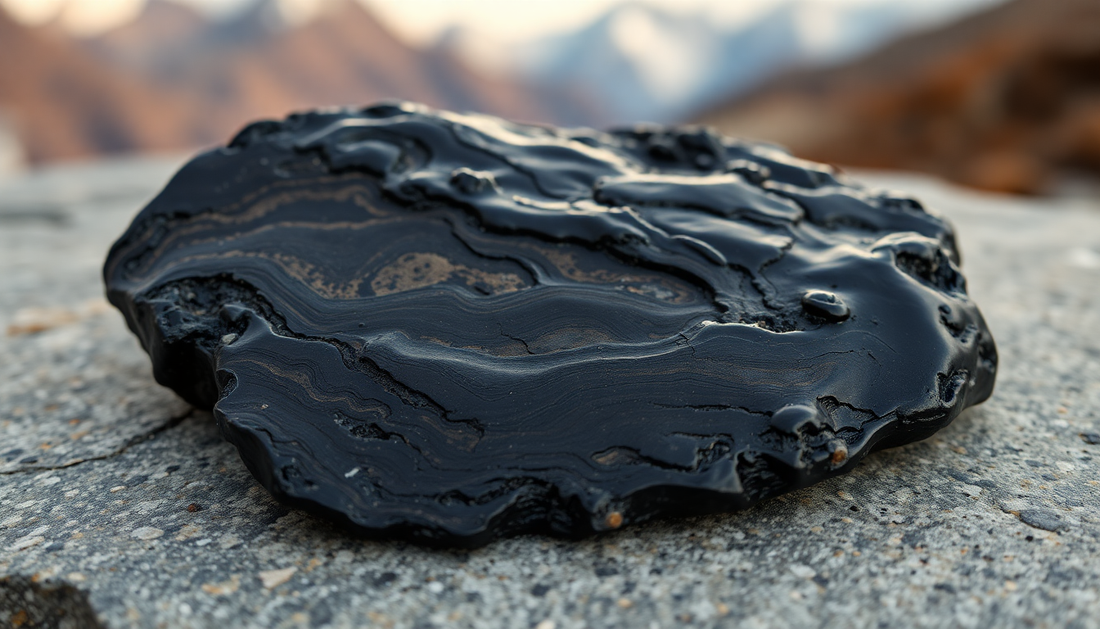Le shilajit, une substance naturelle remarquable trouvée dans les montagnes reculées de l'Himalaya, est vénéré depuis des siècles pour ses remarquables bienfaits pour la santé. Cette ancienne « sueur de pierre » est un véritable trésor de minéraux essentiels, de vitamines et de puissants antioxydants qui contribuent au bien-être général. Cependant, avec sa popularité croissante, le marché est saturé de produits contrefaits et frelatés. Il est donc crucial d'apprendre à identifier la résine de shilajit authentique et de haute qualité.
Dans ce guide complet, nous vous plongerons dans l'univers du Shilajit authentique, en explorant ses origines, ses utilisations traditionnelles et les caractéristiques clés qui le distinguent des imitations. Que vous soyez un amateur de Shilajit chevronné ou que vous débutiez, cet article vous apportera les connaissances nécessaires pour prendre des décisions éclairées et tirer le meilleur parti de cette ressource naturelle remarquable.
Comprendre la résine Shilajit
Le shilajit, également appelé « poix minérale » ou « sueur des montagnes », est une substance collante et résineuse qui suinte des fissures et crevasses des roches himalayennes de haute altitude. Cette substance unique est le résultat d'un processus séculaire de décomposition de matières organiques, notamment végétales, minérales et micro-organismes.
La formation de Shilajit est une véritable merveille de la nature. Au fil du temps, la chaleur et la pression intenses de l'Himalaya ont transformé ces matières organiques en un composé complexe et riche en nutriments. Il en résulte une substance riche en un large éventail de minéraux essentiels, dont le fer, le calcium, le magnésium et le zinc, ainsi qu'en une variété de composés bénéfiques comme l'acide fulvique, l'acide humique et les dibenzo-α-pyrones.
Traditionnellement, le shilajit est utilisé en médecine ayurvédique et populaire pour ses vertus supposées bénéfiques pour la santé et le bien-être général. Qu'il s'agisse d'améliorer les fonctions cognitives, de stimuler l'énergie ou de soutenir la santé cardiovasculaire et le système immunitaire, le shilajit est vénéré pour ses remarquables propriétés thérapeutiques.
Caractéristiques clés de la résine Shilajit de haute qualité
Il est crucial d'identifier une résine Shilajit authentique et de haute qualité, car le marché regorge de produits contrefaits et frelatés qui peuvent ne pas offrir les mêmes bienfaits, voire être potentiellement nocifs. Voici les caractéristiques clés à prendre en compte pour choisir une résine Shilajit authentique :
Apparence et texture
La résine Shilajit authentique doit avoir une consistance collante, semblable à du goudron, d'une teinte brun foncé ou noirâtre. Sa texture doit être lisse et malléable, sans impuretés ni corps étrangers visibles. Le Shilajit authentique peut également présenter un aspect légèrement brillant.
Odeur et goût
Une résine de Shilajit de haute qualité doit avoir un arôme terreux distinct, rappelant le sol humide d'une forêt. Son goût doit être légèrement amer, avec une subtile saveur minérale. Évitez les Shilajit à l'odeur forte et désagréable, ou au goût trop amer ou métallique, car cela pourrait indiquer une falsification ou une mauvaise qualité.
Solubilité et dissolution
Une fois placée dans l'eau, la résine Shilajit authentique devrait se dissoudre progressivement, formant une solution foncée et ambrée. Elle ne doit pas flotter à la surface ni laisser de particules ou de résidus non dissous. Si la résine Shilajit ne se dissout pas complètement ou laisse une quantité importante de sédiments, cela peut indiquer la présence d'impuretés ou d'adultération.
Tests d'authenticité pour la résine Shilajit
Pour vous assurer d'acheter de la résine Shilajit authentique, il est essentiel d'effectuer quelques tests simples pour en évaluer la qualité et la pureté. Voici quelques méthodes fiables pour identifier la véritable résine Shilajit :
Test de solubilité dans l'eau
L'un des moyens les plus fiables de vérifier l'authenticité du Shilajit est le test de solubilité dans l'eau. Versez une petite quantité de résine de Shilajit dans un verre d'eau et observez son comportement. Le Shilajit authentique devrait se dissoudre progressivement, formant une solution sombre et ambrée. Si la résine flotte à la surface ou laisse une quantité importante de particules non dissoutes, cela peut indiquer une falsification.
Test de flamme
Un autre test simple pour déterminer l'authenticité du Shilajit est le test de la flamme. Déposez une petite quantité de résine sur une surface métallique et approchez-la d'une flamme. Le Shilajit authentique devrait fondre et dégager un arôme terreux distinct. Si la résine s'enflamme ou brûle avec une flamme noire, cela peut indiquer la présence d'impuretés ou d'adultérants.
Test d'exposition au soleil
L'exposition directe de la résine de Shilajit à la lumière du soleil peut également fournir de précieuses indications sur sa qualité. La véritable résine de Shilajit devrait foncer lorsqu'elle est exposée au soleil, tandis que les produits contrefaits ou frelatés peuvent ne pas présenter cette caractéristique.
Indicateurs de composition chimique et de pureté
En plus des caractéristiques physiques et des tests d'authenticité, il est essentiel de prendre en compte la composition chimique et la pureté de la résine Shilajit pour garantir que vous obtenez un produit de haute qualité.
Teneur en acide fulvique
L'un des indicateurs clés de la qualité du Shilajit est sa teneur en acide fulvique. Cet acide est un puissant antioxydant et est considéré comme responsable de nombreux bienfaits pour la santé du Shilajit. Un Shilajit authentique doit contenir une quantité importante d'acide fulvique, généralement comprise entre 2 % et 8 % de son poids.
Présence de minéraux essentiels
La résine Shilajit de haute qualité doit également contenir une variété de minéraux essentiels, notamment du fer, du calcium, du magnésium et du zinc. Ces minéraux jouent un rôle crucial dans le soutien de diverses fonctions corporelles et la santé générale.
Absence de contaminants et d'adultérants
Le Shilajit authentique doit être exempt de tout contaminant ou adultérant, comme les métaux lourds, les pesticides ou les composés synthétiques. Ces impuretés peuvent non seulement diminuer son efficacité, mais aussi présenter des risques potentiels pour la santé.
Considérations relatives à l'approvisionnement et à la récolte
La qualité de la résine de Shilajit dépend également fortement de son origine géographique et des pratiques de récolte employées. Le véritable Shilajit se trouve généralement dans les régions reculées et de haute altitude de l'Himalaya, où les conditions environnementales et les caractéristiques géologiques uniques contribuent à sa formation.
Lors de l'approvisionnement en shilajit, il est essentiel de s'assurer qu'il est récolté auprès de sources fiables et durables, selon des méthodes éthiques et respectueuses de l'environnement. Évitez le shilajit provenant de régions connues pour leur pollution environnementale ou récolté d'une manière susceptible de nuire au fragile écosystème himalayen.
Emballage et stockage
Un emballage et un stockage appropriés sont également essentiels pour préserver la qualité et la puissance de la résine Shilajit. Le Shilajit authentique doit être conditionné dans des contenants hermétiques et résistants à la lumière, comme des bouteilles en verre foncé ou en plastique opaque, afin de le protéger de l'air, de la lumière et de l'humidité.
La résine Shilajit se conserve idéalement dans un endroit frais et sec, à l'abri de la lumière directe du soleil et de la chaleur. Une exposition à des températures élevées ou à l'humidité peut dégrader la résine et diminuer ses propriétés bénéfiques.
Tests et certifications par des tiers
Pour garantir l'authenticité et la pureté de la résine de Shilajit, il est fortement recommandé d'acheter des produits testés et certifiés par des organismes indépendants. Privilégiez les compléments alimentaires à base de Shilajit testés par des laboratoires indépendants réputés et certifiés par des organismes de certification de confiance, tels que les BPF (Bonnes Pratiques de Fabrication) ou l'USP (Pharmacopée américaine).
Ces certifications fournissent une couche d'assurance supplémentaire que la résine Shilajit a été rigoureusement testée pour sa qualité, sa pureté et sa sécurité, vous donnant la certitude que vous achetez un produit authentique et de haute qualité.
Idées fausses courantes et faux Shilajit
Malheureusement, la demande croissante de Shilajit a également entraîné une prolifération de produits contrefaits et frelatés sur le marché. Il est crucial d'être conscient des idées fausses et des signaux d'alarme associés aux faux Shilajit afin d'éviter d'être victime de ces pratiques trompeuses.
On pense souvent à tort que la résine de Shilajit doit être brillante, éclatante ou de couleur uniforme. En réalité, le véritable Shilajit peut présenter une gamme de teintes, du brun foncé au noirâtre, et peut même présenter un aspect légèrement irrégulier ou marbré. Évitez les Shilajit trop uniformes ou anormalement éclatants, car cela pourrait être le signe d'une falsification.
Un autre signal d'alarme est le Shilajit vendu à un prix anormalement bas. Le Shilajit authentique et de haute qualité est un produit rare et sa récolte demande beaucoup de travail. Des prix trop beaux pour être vrais peuvent donc indiquer la présence de Shilajit contrefait ou de qualité inférieure.
En vous renseignant sur les caractéristiques du Shilajit authentique et en étant vigilant lors de vos achats, vous pouvez vous assurer que vous obtenez le produit authentique et de haute qualité qui peut véritablement soutenir votre santé et votre bien-être.
Conclusion
La résine de shilajit est un trésor naturel remarquable, offrant de nombreux bienfaits potentiels pour la santé. Cependant, face à la popularité croissante de cette substance ancestrale, il est crucial de pouvoir identifier le shilajit authentique et de haute qualité afin de profiter pleinement de cette ressource naturelle remarquable.
En comprenant les caractéristiques clés, en effectuant des tests d'authenticité et en tenant compte de la composition chimique et des indicateurs de pureté, vous pouvez explorer le marché du Shilajit en toute confiance et trouver le Shilajit authentique et de haute qualité qui accompagnera véritablement votre parcours de santé holistique. N'oubliez pas qu'investir dans du Shilajit authentique, c'est investir dans votre bien-être général ; prenez donc le temps de faire un choix éclairé et profitez pleinement des bienfaits de ce remarquable trésor naturel.
















































